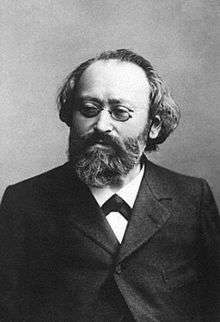Violin Concerto No. 3 (Bruch)
Max Bruch's Violin Concerto No. 3 in D minor, Op. 58, was composed in 1891 and dedicated to the violinist/composer Joseph Joachim, who had persuaded him to expand a single movement concert piece into a full violin concerto.
| Violin Concerto | |
|---|---|
| by Max Bruch | |
 | |
| Key | D minor |
| Catalogue | Op. 58 |
| Period | Romantic |
| Genre | Concerto |
| Composed | 1891 |
| Movements | 3 |
| Scoring | Violin & Orchestra |
It has never attained the same prominence as the G minor concerto.
Description
In 1891 Bruch composed his Violin Concerto No. 3 in D minor, Op. 58, which was dedicated to his friend (and superior at the Berlin Academy of Music) the violinist/composer Joseph Joachim, who had persuaded him to expand what had started out as a single movement concert piece into a full violin concerto.[1] Joachim was the soloist at the work's premiere, in Dusseldorf in May 1891.[1]
Despite being advocated by Joachim and Pablo de Sarasate, the concerto, which differed from its predecessors in its adherence to traditional classical structures, never attained the same prominence as the G minor concerto.
In recent years the concerto has been described as "...a musical unicorn: since it has almost never been played, its existence is for many the stuff only of musicological folklore."[2] Program notes for a 2013 performance of the G minor concerto by the Atlanta Symphony Orchestra even denied the existence of the concerto, stating that Bruch had composed only two violin concertos, the G minor concerto and the D minor concerto composed for Sarasate.[3]
Structure
The concerto has three movements:
- Allegro energico
- Adagio
- Finale: Allegro molto
A typical performance lasts around 38 minutes.
Video Example
Bruch Violin Concerto No. 3 in D minor, Op.58 performed in 2011 by Liviu Prunaru and the George Enescu Philharmonic Orchestra under Horia Andreescu.
- "I. Allegro energico". Youtube. 2011-03-20. Retrieved 2016-09-05.
- "II. Adagio". Youtube. 2011-03-20. Retrieved 2016-09-05.
- "III. Finale: Allegro Molto". Youtube. 2011-03-20. Retrieved 2016-09-05.
References
- Notes
- Sources
- Anderson, Keith (2009). Bruch: Violin Concertos Nos. 2 and 3 (CD). Naxos Records. No: 8.557793.
- Johnston, Blair (2013). "Violin Concerto No.3 in D minor, Op. 58". Answers.com. Retrieved 2016-09-05.
- Meltzer, Ken (2013). "Program notes to Concerts of January 24 & 25 2013". Atlanta Symphony Orchestra. Retrieved 2016-09-05.
External links
- Violin Concerto No.3, Op.58 (Bruch, Max): Scores at the International Music Score Library Project (IMSLP)
- "Max Bruch - Violin Concerto no. 3 in D minor". TheTutorPages.com. Retrieved 2016-09-05.
- Fitfield, Christopher (2005). Max Bruch: His Life and Works. Boydell Press. ISBN 1-84383-136-8.
- Maynard, Rob (October 2009). "Classical Music Reviews: Bruch Violin Concertos 2 & 3, Naxos 8.557793". Musicweb.com. Retrieved 2016-09-05.
- Potter, Tully (2014). "Liner Notes to The Romantic Violin Concerto 17: Max Bruch - Violin Concerto Nº.3 in D-minor, Op. 58, CDA68050" (PDF). Hyperion Records.
- Wood, Thomas. "Max Bruch Home Page, Catalog of Works". Wooster College. Archived from the original on 2011-06-02. Retrieved 2016-09-05.